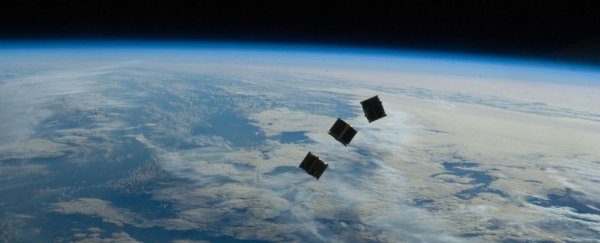A team of space engineering graduate students at MIT has developed an electric propulsion engine that could be used to help nano-satellites maneuver in orbit and voyage to the Moon.
The team was one of three groups funded by NASA to develop a lightweight propulsion system to help small spacecrafts like CubeSats, which are about the size of a coffee mug, change their orbits.
Unlike chemical propulsion systems, which produce thrust by burning some kind of fuel, the team's device uses ion propulsion. Charged particles in the propellant fluid are accelerated with electromagnetic force, and ejected from a thruster, driving the craft in the opposite direction.
While it can't achieve the same velocities as chemical propulsion, it's more efficient. "For the same mission, an electric propulsion system can use up to 1,000 times less propellant by mass," the developers say.
The team has spun out a company called Accion Systems, and in February they tested their prototype in the lab. They are scheduled to fly their engine on a CubeSat for the first time this week, reports Evan Ackerman at IEEE Spectrum.
CubeSats are one of the most efficient ways to get to space on a shoestring budget. Since the year 2000, more than 300 of these standardised nano-satellites have been launched, and that number is expected to eclipse 3,000 sometime in the next five years.
They've essentially opened the floodgates for everyone from student groups and amateur enthusiasts to start putting payloads into space, and are a driving force behind the evolution of a coherent space strategy in Africa.
While their size is great for keeping costs down - it's estimated the total cost for a CubeSat mission, including launch, is between $100,000 and $200,000 - it tends to limit what they can do.
With no engine, "CubeSats are dumped into orbit and left to fend for themselves, tumbling aimlessly until drag pulls them to Earth after a few months or so," explains Ackerman.
NASA wanted to develop a system that could help these small satellites perform more functions by moving around, which would have the added benefit of extending their lifespan.
The MIT ion electrospray thruster system is just 2-cm thick, harvests power from solar panels on the spacecraft's exterior, and can change the velocity of a cubecat by up to 100 metres per second.
Ackerman says a a 6U CubeSat platform - which consists of six connected CubeSats, and is about 60cm long - could leverage the MIT-developed thrusters to reach the Moon.
"And once you're able to escape from Earth orbit, the entire solar system is out there to be explored, opening up possibilities for interplanetary missions that are an order of magnitude more affordable than they are right now," he says.
The team says their system can add maneuverability and lifetime to small satellites and can be scaled up to support satellites up to 2000 kg. You can watch one of their early lab demos in the below video.

